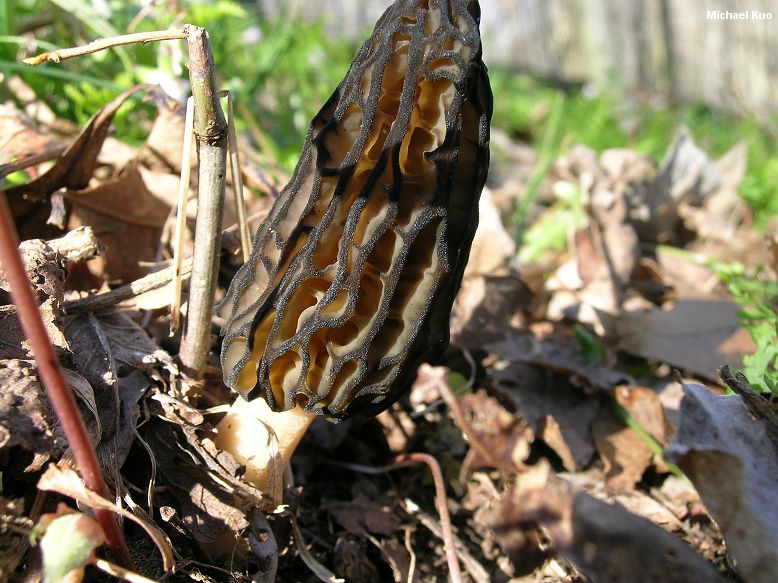

This section is a quick explanation of some of the identifying characteristics of Morchella species which fall into the taxonomic family Morchellaceae.
As with all of these pages, they are NOT intended to be used as a key or diagnostic tool, but a guide of basic identifying characteristics so that you can make informed decisions and easy-access to other, more detailed resources.
Morchella, True Morels
 Morchella, The Morels
Morchella, The Morels
Morchella are mycorrhizal, meaning that they grow in association with plants, usually trees. Some trees/plants they are believed to be mycorrhizal with include privet, apple, elm, ash and oak. They often fruit in moss-beds or regions of disturbed soil and grow in clusters, gregariously, or alone. Morels like to grow with stable soil temps of about 55F in the very early Spring. Check for them on slopes and fields that hold moderate moisture (intermittent sun exposure).
The fruitbody of Morchella spp. have large asymmetrical pits inside of which the microscopic ascus (sac) hold spores for dispersal upon disturbance (like when the wind blows). The stipe AND cap will ALWAYS be hollow. The color of the pileus (cap) is variable from yellow-tan-grey-dark brown and often have blackened edges when they dry with age.
Two misconceptions regarding morels: there are no "grey morels" on the east coast. Our grey morels are just young specimens of some of our yellow morel species. Also, the "burn morels" that fruit after forest fires do not occur east of the Rocky Mountains. Determining to species can be a tricky endeavor when it comes to morels, but they all share some key features that can ID them as "morels"
Photo by Jean Cox
Where in Alabama?
|
|
Features
|
M. angusticeps is our known "black morel" species. Photo by Michael Kuo |
 Hollow True Morels all have a completely hollow stipe and body. If they are solid or contain wispy, cottony fibers, then they are not true morels. |
This genus is defined by the pronounced pits, and hollow stipe/body. The fruitbody of Morchella spp. have large asymmetrical pits inside of which the microscopic ascus (sac) hold spores for dispersal upon disturbance (like when the wind blows). The stipe AND cap will ALWAYS be hollow. The color of the pileus (cap) is variable from tan-grey-dark brown and often have blackened edges when they dry with age. Photo by Jean Cox |
Cook Well!
Morels dry and reconstitute remarkably well and store (completely dry) for years! I've also quite successfully powdered the cooked and dried fruitbody as a robust, meaty seasoning. Morels and their allies need to be cooked thoroughly. They are toxic if under-cooked. That means that even if you are going to powder the mushrooms as a seasoning/salt, you should bake them (~170F) before powdering. If cooking to eat immediately, we recommend cutting them up and cooking thoroughly to avoid any GI upset.
Lookalikes
The genus Gyromitra also fall into the phylum of ascocarps and are often the harbingers of Morchella (or at least they tend to like the same general environments and fruit at about the same time of year). While these too have a hollow stipe and cap, they will lack the very distinctive pits seen with Morchella. Some of the species in this genus produce a toxin called gyromitrin, which can cause renal failure. Our stance at the AMS is to not eat them as they are not 'beginner' mushrooms. |
Please remember to seek other sources for confirmation before consuming any wild mushroom

%2012%20March%20Morels%20Tim%20Pfitzer.jpeg)




